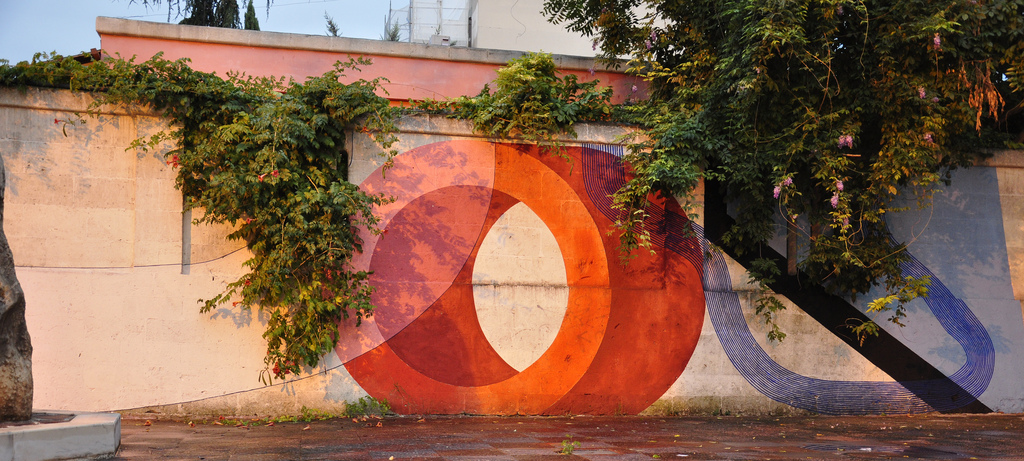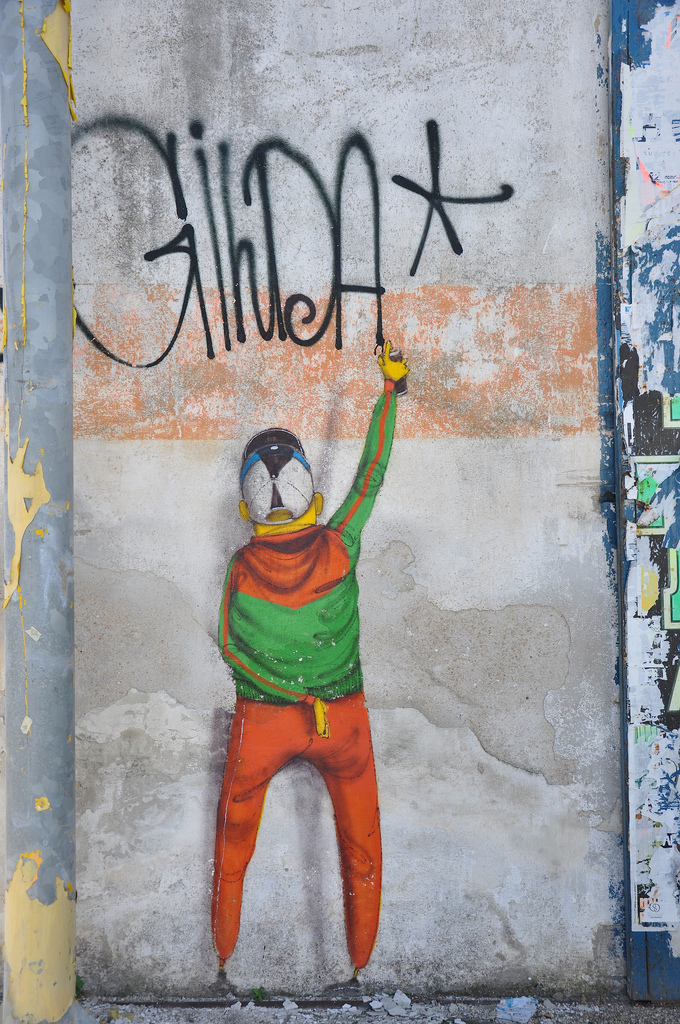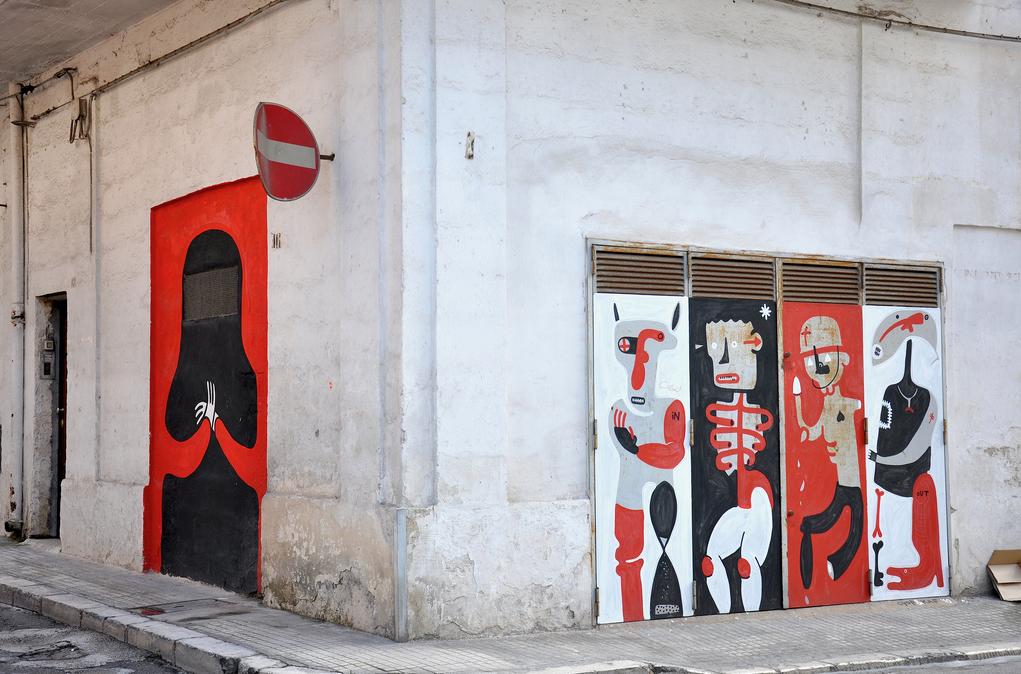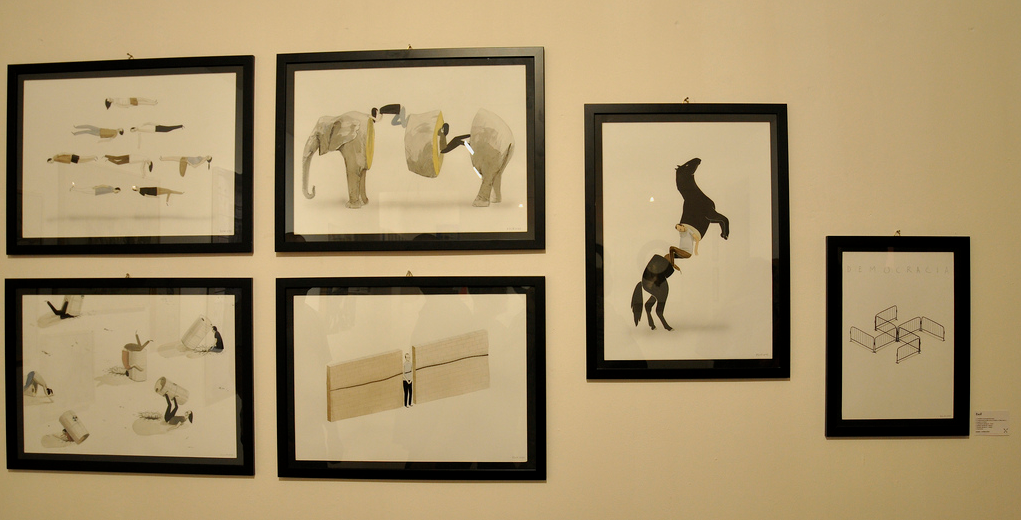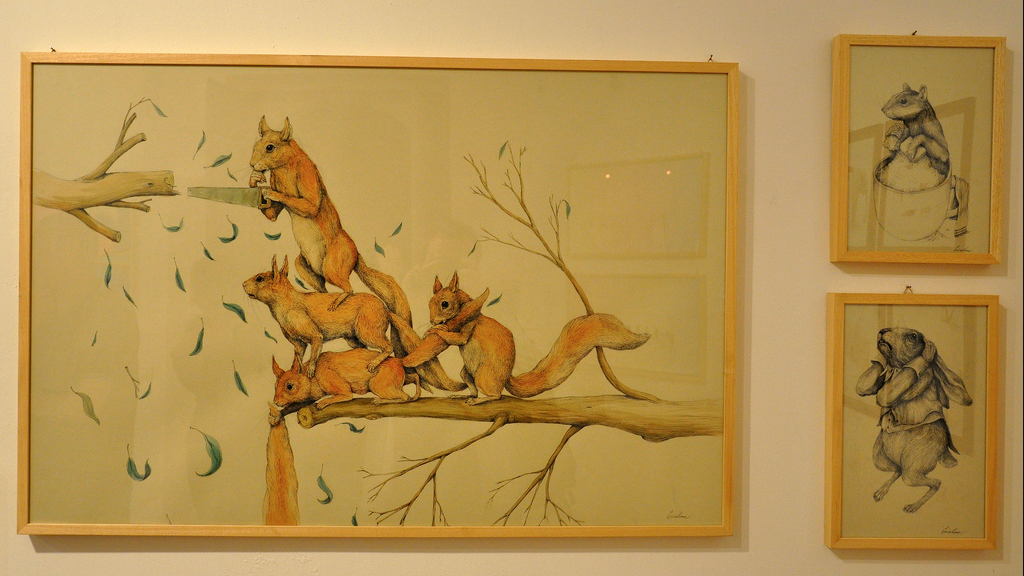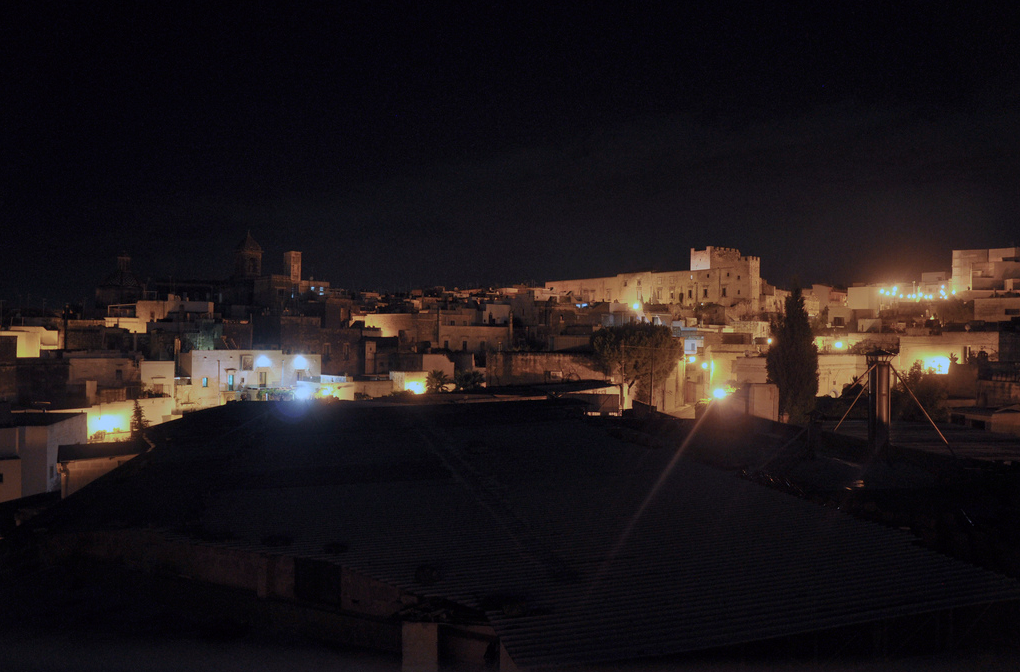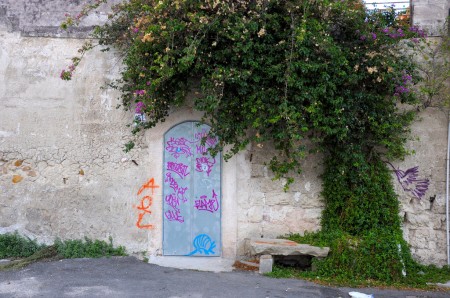For the last two years, there’s only one place even the most half-hearted of street art fan should be in September and that’s the picturesque town of Grottaglie, in the foot of Italy, and this year is no exception as the town again provides the canvas for curator Angelo Milano’s FAME Festival.
As with previous years, Angelo has invited a stylistically and geographically diverse selection of renowned and, at least for now, less recognized artists to decorate the walls of his hometown as they see fit. Perhaps the most notable change from previous years is a move from figurative artists into the realms of abstraction in the form of Italian artist 108 and global wanderer but, most recently, NYC based, MOMO.
Read on for many more words and photos from AM contributor, Mike Stafford.
108’s doomy black abstractions are engaging and challenging in equal measure. Whether it be within the confines of a small room in the abandoned monastery, where the large triangular constructions are most effective and have the effect of warping and playing with the room’s dimensions as the viewer attempts to back away and comprehend the pieces, or as a surreal floating void on a wall beside a busy road, these are potent works. Like all good abstract art they force the viewer to take their own interpretations away and whilst some can easy walk on by, this spectator found them to be captivating and fascinating in both their effect on their environment and their ability to hold one’s attention. Sadly, they also have a black hole like attraction to the town’s taggers who have done their best to spoil the monastery pieces. That’s the nature of the game though and the taggers can surely claim a territorial right to the walls of their town.
On a similarly obtuse tip, MOMO has brought his equally abstract, but considerably more colourful, wall art to a number of walls and billboards. The highlight for this viewer being a wonderful piece in the heart of the ceramic quarter which takes the vertical stripes of an existing corrugated roof and extends them in an elegant skywards sweep, wonderfully augmented with collapsing, curving bands of colour. The result is a beautiful contemporary addition to the skyline of the old town.
Fusing the abstract with the figurative is British artist Lucy McLauchlan who, for the third year running, brings her flowing art deco and tribal influenced imagery to the streets of Grottaglie. Of three new walls, the highlight for this spectator is an illegal piece painted on a small sub-station type building where the artist has cleverly improvised, with the addition of two billowing face clusters emerging from a pair of grilled windows, on two walls of the structure. Each wall contains a couple of dozen of the artists distinctive enigmatic faces with, in a nice touch, one wall showing far sadder, more resigned looking folk than the other, more animated wall. Lucy has also painted a substantial three-sided wall in a small car park with a knotted, rope-like form, which upon closer inspection reveals a pair of birds greeting each other over their nest, sited below a bold, rising (or setting, dependent upon your outlook) sun. Spectacular.
Grottaglie’s walls have been generously daubed by Brazilian superstars Os Gemeos, who leave numerous of their signature yellow skinned characters across the old and ceramic districts of town. It’s hard to pick a favourite, such is the fineness of the execution and the unique personality of each character, but I’d have to swing for the chap stretching to pay tribute to Angelo’s mother, and all round super-host, Gilda. Elsewhere the characters are seen forcing themselves in and out of walls in fine demonstrations of the incredible three dimensionality Os Gemeos are able to realize using the relatively crude tool of tins of spray paint. As well as their fine characters, Os Gemeos have also left multiple tags and a couple of fine throw-ups around town. Sadly, one character, who appeared to be befriending a chicken in a manner which may (and did) raise eyebrows in polite company, has been painted over. No doubt it’s its position facing a substantial religious shrine/statue was a motivating factor in its defacement.
Vhils left just the one piece on the streets this year but it’s quite the piece – a large scale portrait of cinema icon Humphrey Bogart (I am unsure what, if any relevance, this particular image has to Vhils or Grottaglie) chipped out of the brickwork of a side street in a prominent position on one of the main drags into town. It looks particularly effective at night as the light catching the chipped brickwork gives the illusion of Bogie being backlit from behind, a fine reminder of the silver screens on which he lived.
However many times one sees a Swoon image, and she is certainly not shy about populating new locales with familiar imagery, it is hard not too be anything less than impressed, and a little taken aback, with just how effective they are once in situ. Whether their aging is gentle, due to weathering, or hastened by human intervention, there is a timeless quality, a permanence, to the pieces, which engenders a great empathy for the subjects and the environment in which they are placed. Whether the images are of the disenfranchised or disaffected, or of beloved family members, Swoon’s pasted tributes are evocative reminders of people and their lives within built environments around the world. Confusion was caused by the presence of some very Swoon-like pasters around town, with excited whispers of new imagery being debuted, as the images were certainly good enough, superficially at least, to be mistaken for Swoon but were in fact by an artist whose name is unknown at the time of writing.
Colombian artist Bastardilla divided opinion amongst my companions and her busy, bold, stylized characters may well have an element of the marmite about them. The use of quite extraordinary amounts of glitter, in conjunction with bold black outlining and vibrant primary and acid coloured fills, certainly makes them eye-catching and perhaps a little overwhelming. I’ve certainly come to appreciate the work having taken time to look more closely at photos taken over the weekend than perhaps I did at the time. Her piece in the old quarter was the highlight for me thanks to it’s positioning on a wall which is only visible after the viewer rounds a blind corner which, consequently, gives it the wonderful element of surprise and discovery which the street environment will always have as an advantage over indoor/gallery spaces. It’s a fine piece in its own right and clearly enjoyed by some of the local residents. On our visit a little old lady, out taking her grandchild for a walk, was at great pains to make sure that we also saw a face which Bastardilla had painted onto a grill set at floor level and set back a foot into a stone wall which I’m pretty sure we’d have otherwise not spotted.
Cyop & Kaf are also first time visitors to FAME and bring a selection of bizarre characters, reminiscent of the mutant offspring of an unholy fusion between last years attendee DEM and the previous years visitor, Sickboy. The highlight was a large and rather flamboyant character painted on the side of a seemingly pointless tower toward the edge of town. Also worthy of note, for its clever use of the environment, was a clever use of the environment was a bold red and black burkha clad figure whose face-mask was represented by an existing grill in a door. There was also a rather regal, if somewhat surreal, pope type figure located, appropriately enough, in the old monastery.
Italian street legends, and two of the most consistently exciting street artists in the world, Blu and Erica Il Cane brought their trademark huge scale and equally huge visions to the large walls of the apartment blocks on the west of town. Blu offers a typically scathing environmental commentary in the form of an immense toxic cake being proffered on a ceramic plate by a bling embellished pin striped arm – a cry out against the ongoing selling of the beautiful olive grove rich countryside which surround Grottaglie land for the purposes of waste burial. The resultant wall is characteristically spectacular in both it’s scale and the extraordinary detail of its rendering (surpassing even that of two sketches of the image exhibited at the gallery show).
Il Cane delivered two wonderful walls of his signature Victorian illustration styled animals acting out their human tragedies. One wall shows a dazzlingly bright frog prince holding aloft his crown on a cushion, presumably a reference to the Grimm fairly tale although it’s relevance to Grottaglie is unknown. The second wall portrays a beautifully rendered deer hosting a modest village of birdhouses in its antlers and feeding a bird in an attempt to encourage the settlement of his horns, it’s a fine example of Il Cane’s tenderly observed eco-awareness. In both of these impressively scaled works Il Cane demonstrates his extraordinary ability to portray human emotions on the very non-human faces of his subjects. Peerless really.
Spanish silhouette master Sam3 was back in town bringing a number of new works to the streets, with alluring and seductive women being a bit of a theme. The most striking piece is a very large wall showing a giant female figure beckoning a little chap who, no doubt seeing her as not his type (if only due to the significant difference in height), desperately attempts to ward off his admirers attentions with a brush. It’s funny, bold, and a great example of the artist’s blend of the fantastical and the humorous. Another fine piece shows a number of ghostly white sirens trying to pull a male figure from the safety of his skinny ladder and into shining light of an overhanging lamp. He seems as unwilling as the little chap battling the 50ft woman.
Fellow Spaniard Escif arrived in town with a bundle of watercolours under his arm for the gallery show which left him more time to paint walls. Which he did with a vengeance, contributing five great examples of his surreal world view. The horse and tree were very fine indeed although an explanation of the tree piece, in Italian (to non-Italian speakers), by a deranged old woman, failed to enlighten this viewer as to the meaning of the works.
British artist Word To Mother also makes a welcome return and has clearly had fun in writing his ‘Mother’ moniker large as negative graffiti pieces in his signature font on several walls around town. Whilst larger than life scale is often a source of wonder in it’s own right, I most enjoyed the smaller scale piece painted on a piece of rusting metal beside a town house door where WTM shows his skill in transforming something reasonably mundane and anonymous into something rather lovely and anything but anonymous. Mother’s work this year is the closest in style to traditional graff/writing by any of the visiting artists, but when it’s done with such style and sympathy for placement it’s easy to see why the townsfolk are happy to chat with and fuel him as he worked. Apart from the guy with the paint splattered car of course.
Boris Hoppek makes a welcome return to the streets after several years absence with, most conspicuously, a thirty meter long illegal piece along the walls of the football stadium. Boris’ work here is concerned with immigration and features a multitude of his distinctive black, open eyed, red-lipped, larger than life characters clutching their documents, but absolutely nothing else, as they queue along the wall. Boris also decorated the walls of the monastery with several (seemingly) more light-hearted pieces such as the pair of ghosts rushing to the doorway, the sight of which make the shouting of a ghost-like ‘woooh-hoooo’ almost unavoidable. Dignity prevailed.
Accompanying the street work is a gallery exhibition of original work, on a variety of mediums ranging from ceramics to corrugated steel, alongside printed editions by almost all of the artists (Os Gemeos being the significant omission). The vast bulk of the work was created during the artist’s residencies in town and even, in the case of Word to Mother and Lucy McLauchlan, from assembled and painted pieces of the town’s own detritus. Stars of the show for this viewer were Erica II Cane’s beautifully rendered watercolours and drawings but there was an abundance of high quality contributions from all of this years attending artists which made for a strong group showing.
Apart from the pleasure of spending hours engrossed in dull analysis of the work on the streets, there is a whole bundle of real pleasure to be had in a visit to FAME. There is the wonderfully warm reception from Angelo, his family and friends, the entertainingly erratic approach of Italian hotel and B&B managers, the wonderful food, the fine weather (ignoring the torrential rain of course) and the simple pleasure of wandering streets searching for, and finding, beauty on the walls. It’s particularly heartening to hear that the town leaders are finally starting to understand Angelo’s vision and intentions and even that they may be finally recognizing that the town is a far more pleasant place to live in with the street art than without it. Certainly, the residents we spoke with over the weekend seemed to take pride and pleasure from the artist’s contributions to their town. That said, there was still some degree of incredulity that so many people had actually traveled to Grottaglie with the sole intention of gawping at walls (and eating as much fine food as possible).
Both surprising and gratifying is how little of the previous years’ street work has been defaced or removed which again reinforces the impression that the town, and its denizens, is comfortable in acting as an annual outdoor gallery. Other than the painted over Os Gemeos, the only piece from previous years to have been removed, to my knowledge at least, was David Ellis’ lovely flow painting. Everything else appears as intact and pristine as the elements have allowed.
FAME is a great example of what can be achieved though a love of the art, an awful lot of patience and the application of serious hard work and, in a world of street art events sponsored by everyone and everything from car companies to spray paint suppliers, it’s refreshing to see that an event of this scale can still be achieved without a penny of sponsorship so one hopes that, instead of hassling Angelo Milano, the town leaders begin to actively encourage and thank him in future. There are very few towns which have been gifted such an abundance of free art by so many of the worlds leading artists. Roll on next year’s event…
For further information, including excellent tales of the trials and tribulations in getting this art on to the walls of the town, please head to Angelo’s super cool Fame Festival blog. Work from the show is available through the Studiocromie website.
- The masked marauder
- Angelo in front of Word to Mother painting
- Ericailcane
- Erica Il Cane
- Bastardilla
- Escif
- Part of the gallery
- Giorgio – right hand man of Angelo and gracious tour guide
- Grottaglie at night
- 108
- Vhils
- Lucy McLauchlan
- Boris Hoppek
- MOMO
- Os Gemeos
- Sam3
- Blu
- The taggers were also out and about…
- Bastardilla
- Cyop & Kaf
- Swoon
- Lucy McLauchlan
- City of Grottaglie
- Word to Mother
Masked marauder picture courtesy of Clare Long.
For the full photo set, check out Mike’s flickr here.
Discuss the Fame Festival here.





